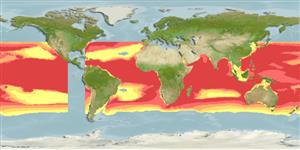Common names from other countries
>
Myctophiformes (Lanternfishes) >
Myctophidae (Lanternfishes) > Diaphinae
Etymology: Diaphus: Greek, dis, dia = through + Greek, physa, phyo = to beget, to have as offspring (Ref. 45335).
More on author: Gilbert.
Environment: milieu / climate zone / depth range / distribution range
Ecologie
marien bathypelagisch; diepte 0 - 2091 m (Ref. 26165). Deep-water; 40°N - 49°S, 78°W - 99°W
Eastern Atlantic: Canary Islands (Ref. 6808) and off Senegal. Western Atlantic: west of 30°W between 36°N and 10°S. Indo-West Pacific: off East Africa, Comoro Islands and west coast of Madagascar; off Japan south of 40°N, southeast Asian seas, Australia (Ref. 7300) and New Zealand (Ref. 5755). Eastern Pacific: near Hawaii, and off Acapulco, Mexico. South China Sea (Ref.74511).
Lengte bij maturiteit / Grootte / Gewicht / Leeftijd
Maturity: Lm ?, range 4 - ? cm
Max length : 6.0 cm SL mannelijk / geslacht onbekend; (Ref. 4479)
Dorsale stekels (totaal) : 0; Dorsale zachte stralen (totaal) : 15 - 16; Anale stekels: 0; Anale zachte stralen: 14 - 17.
Meso- and benthopelagic (Ref. 58302). Pseudoceanic, at 325-750 m by day and nyctoepipelagic at surface to 125 m at night (with maximum abundance at 100 m) (Ref. 4479). Lipid content is 8.7 % in fresh body weight and wax ester is 1.7 in total lipids (Ref. 9193). Often appears with sergestid shrimp Sergia spp., marine hatchetfishes Argyropelecus spp. and Polyipnus spp. (Ref 39633).
Specimens reach sexual maturity at a length of 4 cm (Ref. 47377).
Levenscyclus en paargedrag
Maturities | Voortplanting | Spawnings | Egg(s) | Fecundities | Larven
Hulley, P.A., 1990. Myctophidae. p. 398-467. In J.C. Quero, J.C. Hureau, C. Karrer, A. Post and L. Saldanha (eds.) Check-list of the fishes of the eastern tropical Atlantic (CLOFETA). JNICT, Lisbon; SEI; Paris; and UNESCO, Paris. Vol. 1. (Ref. 4479)
Status op de Rode Lijst van het IUCN (Ref. 130435)
CITES (Ref. 128078)
Not Evaluated
Gevaar voor de mens
Harmless
Gebruik door de mens
Tools
Speciale rapporten
Download XML
Internetbronnen
Estimates based on models
Preferred temperature (Ref.
115969): 5.4 - 14.4, mean 8.6 (based on 1147 cells).
Fylogenetische diversiteitsindex (Ref.
82804): PD
50 = 0.5000 [Uniqueness, from 0.5 = low to 2.0 = high].
Bayesian length-weight: a=0.00646 (0.00351 - 0.01187), b=2.97 (2.81 - 3.13), in cm Total Length, based on LWR estimates for this species & Genus-body shape (Ref.
93245).
Trofisch niveau (Ref.
69278): 3.1 ±0.3 se; based on size and trophs of closest relatives
Weerstandsvermogen (Ref.
120179): Hoog, minimale populatieverdubbelingstijd minder dan 15 maanden (Preliminary K or Fecundity.).
Fishing Vulnerability (Ref.
59153): Low vulnerability (10 of 100).
